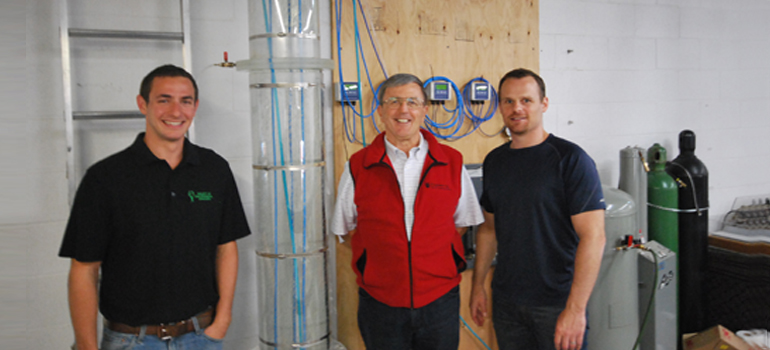L – R: Civil graduate student Tyler Barber, Professor Don Mavinic, and Ken Christison, principal engineer at Northwest Hydraulic Consultants, pictured with the aeration column and dissolved oxygen monitors used for this research.
Supplying oxygen via aeration for water treatment is an energy intensive process, accounting for up to 60% of the energy requirements in a standard activated sludge wastewater treatment facility. Civil Engineering professor Dr. Don Mavinic, adjunct professor Dr. Ken Ashley, and Civil Engineering M.A.Sc. student Tyler Barber have initiated research into the field of “superoxygenation”.
Superoxygenation utilizes high-purity oxygen bubbles and increased operating pressures of an aeration column to increase the partial pressure of oxygen in the aerating bubbles of the column. The research, conducted at Northwest Hydraulic Consultants (NHC), explores the resulting equilibrium between aqueous dissolved oxygen (D.O) and this increased partial pressure of the gaseous oxygen. The increase in gas-liquid equilibrium concentrations, to values of more than 100 mg/L of D.O. at 200 kPa operating pressure, is directly related to the partial pressure of oxygen in the gaseous phase by way of Henry’s law. An air-water interface saturated D.O. concentration rarely surpasses 20 mg/L and in fact in a typical activated sludge treatment plant D.O. values rarely exceed 8 mg/L. Superoxygenation goes beyond the limits that were previously thought to restrict aeration of water.
For the first time aeration mass transfer design parameters, such as: the mass transfer coefficient, oxygen transfer rate, oxygen transfer efficiency, and aeration efficiency, were obtained for a superoxygenation system. Additionally, data using air as the oxygen source was compared to the high-purity oxygen used for superoxygenation to provide base values for a typical aeration system. The results indicate that, over the range of pressures tested, a superoxygenation system is superior to a standard aeration system using air as the oxygen source.
The findings suggest that a superoxygenation aeration system, which provides 10 fold the amount of D.O. as standard aeration, can substantially decrease the volume of water needed to be aerated and thus the total energy consumption and the treatment facility footprint. This research, the first of its kind, provides the initial database for future research into the topic and the first database for D.O. equilibrium values at increased partial pressures. Superoxygenation could potentially transform standard aeration practices that we see today.
